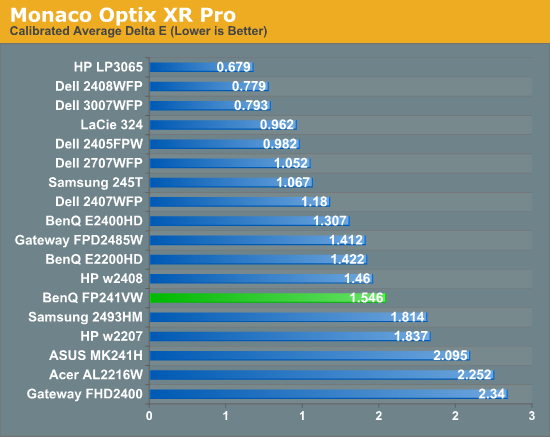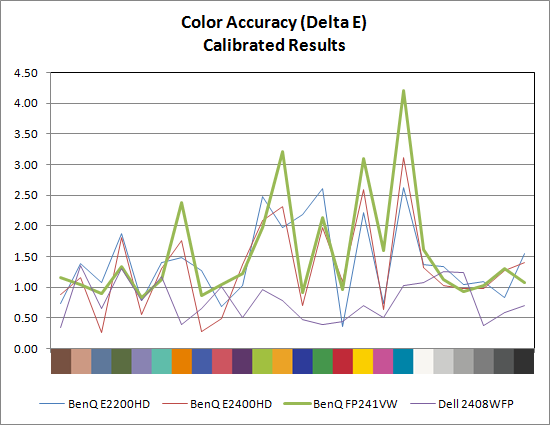Color Accuracy
Imaging professionals definitely like to have accurate colors, and the best way of assuring that your display shows the proper colors is to use a colorimeter and calibration software. However, not everyone has access to such tools and many users are unwilling to spend over $200, so we calibrate and test the various LCDs. We didn't perform a thorough evaluation of color accuracy on the FP241VW, so we will limit our Delta E comparison to calibrated performance where we target a white level of ~200 nits - anything more than that is too bright in our opinion. The FP241VW actually ended up at 270 nits, but that won't substantially affect any of the scores. Before we get to the results, here are the display settings we used on the BenQ LCDs. We let the LCDs stabilize for at least one hour before performing measurements. We will compare results with the Dell 2408WFP, which so far has achieved the best overall color accuracy of any LCD we have tested, as well as the previous two BenQ LCDs.
| LCD Brightness and Contrast Settings | ||
| Standard Calibrated (~200 nits) | Calibrated for Print (~100 nits) | |
| BenQ E2200HD | 65 Brightness, 50 Contrast "Normal" (95-95-95 RGB) |
20 Brightness, 50 Contrast "Normal" (95-95-95 RGB) |
| BenQ E2400HD | 73 Brightness, 50 Contrast "Normal" (94-94-91 RGB) |
30 Brightness, 50 Contrast "Normal" (94-94-91 RGB) |
| BenQ FP241VW | 35 Brightness, 50 Contrast (270 nits) "Normal/sRGB" (47-48-45 RGB) |
N/A |


After calibration, the FP241VW still fails to come anywhere close to the Dell 2408WFP - and in fact it doesn't even match the accuracy of the less expensive E2400HD. That said, it's interesting to note that the color accuracy curves for all three BenQ LCDs are extremely similar, to the point where I now have to wonder if backlighting has a far greater impact on color accuracy than I previously thought. It makes sense that better backlighting would allow the panels to achieve better color accuracy, but I don't have any evidence for this assertion other than the above chart. Anyone serious about color accuracy is probably going to want an average Delta E of around 1.0 or less post-calibration. So far, only S-PVA and S-IPS panels achieve that goal, although it's possible a better backlight would allow the A-MVA display to match the other displays. Note also how the bottom half of the above chart is dominated by LCDs that use TN panels.










114 Comments
View All Comments
TA152H - Saturday, June 20, 2009 - link
Even back 20 years ago, only a certain amount of companies made shadow masks too. Nanao did not make their own, but, yet, their screens were the best. It's not as simple as you make it sound.It's actually possible that NEC might make a better monitor in some instance, although I've never seen it, but, by and large, Eizo is much better. You know when you're looking at an Eizo.
The picture quality is much better than NEC, or anyone else. I'll say this though, I have had uneven reliability with Eizo. Some monitors have been fine, and but more than there should be died quickly or had intermittent problems they should not have. This happens with all monitors, of course, but, in my small sample set, Eizo monitors have had more problems than others, but a small degree.
Clearly, all that money is put into picture quality, not reliability.
darklight0tr - Wednesday, June 17, 2009 - link
Expensive != Quality and Eizo is proof of this.Our internal graphics department recently moved to 24" Eizo monitors at $1700 a pop and HATE them. They are inconsistent across the display, and are no better than the standard DELLs we use for the rest of the environment. They had high expectations for those displays and were really let down and the Eizo rep was no help at all. Its funny how communication diminished as soon as the sale was completed.
What a waste of money.
TA152H - Saturday, June 20, 2009 - link
It's funny, because two people where I work got two Eizo's, and everyone wants them, and comments on them.Even on independent reviews, when they actually do get reviewed, they always are rated extremely highly, except for price. I don't know why your experience would be so much different, but, it sounds like you guys are either stupid (for not looking at the monitors first before buying a bunch), or it's made up.
Probably the latter, since no one would buy a monitor that was really expensive without seeing it and judging it first.
darklight0tr - Monday, June 22, 2009 - link
Wow, a whole two people. What a great example you have there.We have a whole department with them (almost 20 monitors) and while they work okay, most of them don't live up to the price tag. As I said, the colors aren't consistent across the display, even after calibration (yeah, us stupid people actually know how to do that). This happens with pretty much every one we have. We didn't buy them sight unseen either, which would have been pretty moronic. I think it is the backlight that causes many of the issues, which is unfortunate. I hope LED backlight displays help with this problem.
Who cares if they are reviewed well? I have them here in person and they don't live up to the price OR the reviews.
Calling me stupid, how mature. How about not judging me based on your own limited experience?
JarredWalton - Wednesday, June 17, 2009 - link
See, that's the problem: server CPUs start out as super fast but the tech makes its way to consumer products. The same thing has happened with GPUs, HDDs, RAM, etc. to varying degrees - it's all substantially cheaper now and performance has improved. But LCDs? Well, Eizo makes high quality LCDs, certainly, but they cost an arm and a leg. The cheapest 24" Eizo (taking a quick look) is over $800, with other models costing $1500 or more. They may be the best displays on the market, but what I want is to see that quality make its way into $500 LCDs.Spoelie - Wednesday, June 17, 2009 - link
http://translate.google.com/translate?prev=hp&...">http://translate.google.com/translate?p...mp;sl=nl...Launched in japan just yesterday with a $500 pricetag...
Now if only they would sell it abroad as well with a similar pricetag. And we need a review, it's "VA" technology but which one?
Mastakilla - Wednesday, June 17, 2009 - link
Eizo is not at all that good for it's priceFor a similar price you get a muuuuuuch better NEC monitor (check out the xx90 series)
Griswold - Wednesday, June 17, 2009 - link
Not going to happen. Well, maybe eventually the cheapos arrive at todays quality of Eizo, but then Eizo would have moved beyond that again. :PQuality and spending a few hundred bucks just doesnt go together. Buy Eizo and be happy for many, many years - not only due to the 5 years on-site warranty (not that I've ever had to make use of it, though..)
HexiumVII - Wednesday, June 17, 2009 - link
I've been using of those old Soyo 24" with the MVA I got for $250 a few years back, its great, has all the advantages of MVA and color is very accurate with my spyder. At school we have 24" iMacs and the screen is just friggin amazing. It's just so much better than everything else out there. A lot of it has to do with the glossy screen. So here's to a 24" 16:10 screen with gloss for a reasonable price one day.marraco - Wednesday, June 17, 2009 - link
I got crazy trying to play Crisys 2 at the morning on a glossy monitor. There was no way to see clearly the image without reflections. There was no way to accommodate the monitor to reduce reflex.glossy is an absolute crap. I hate it from gut.